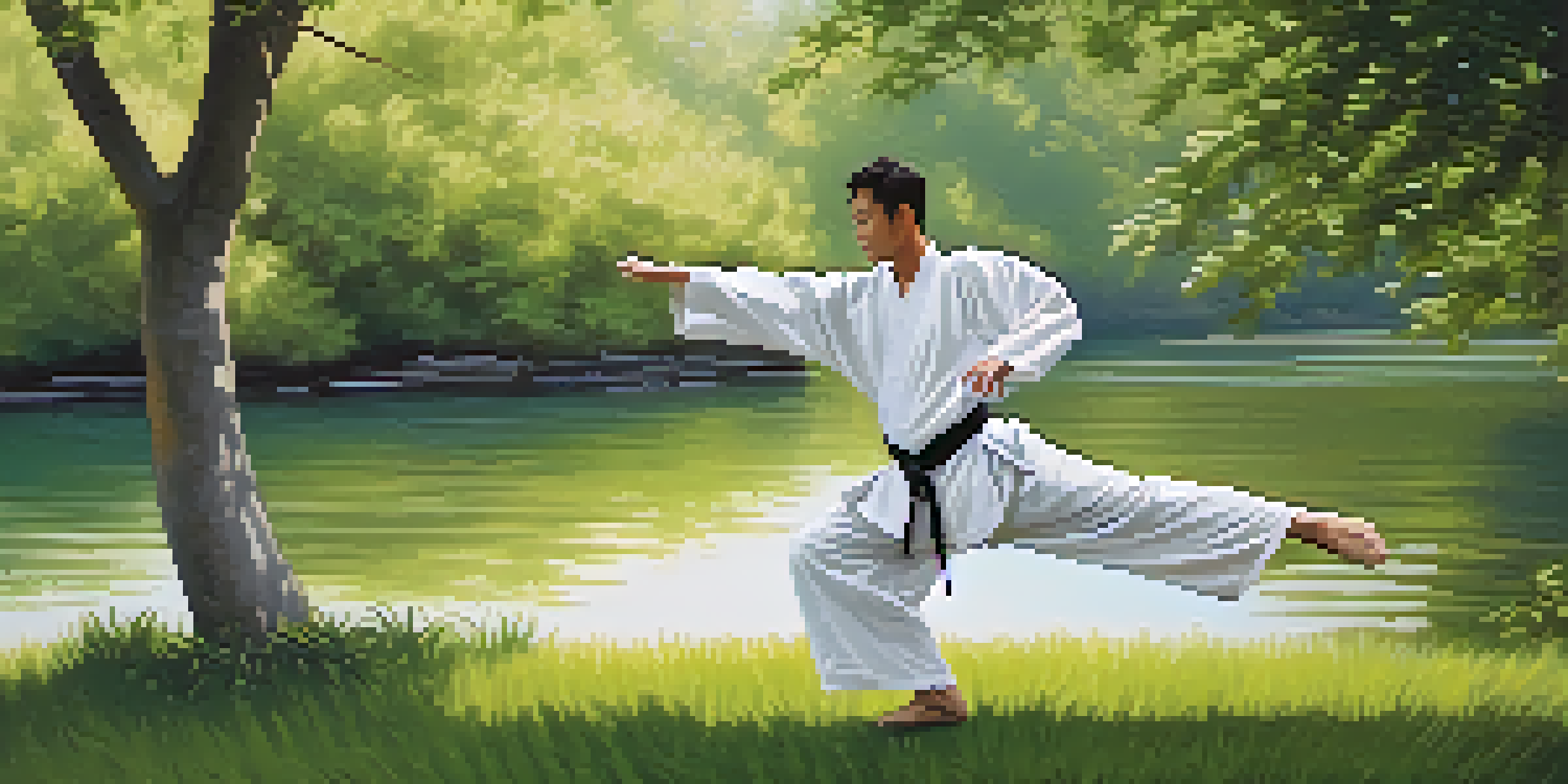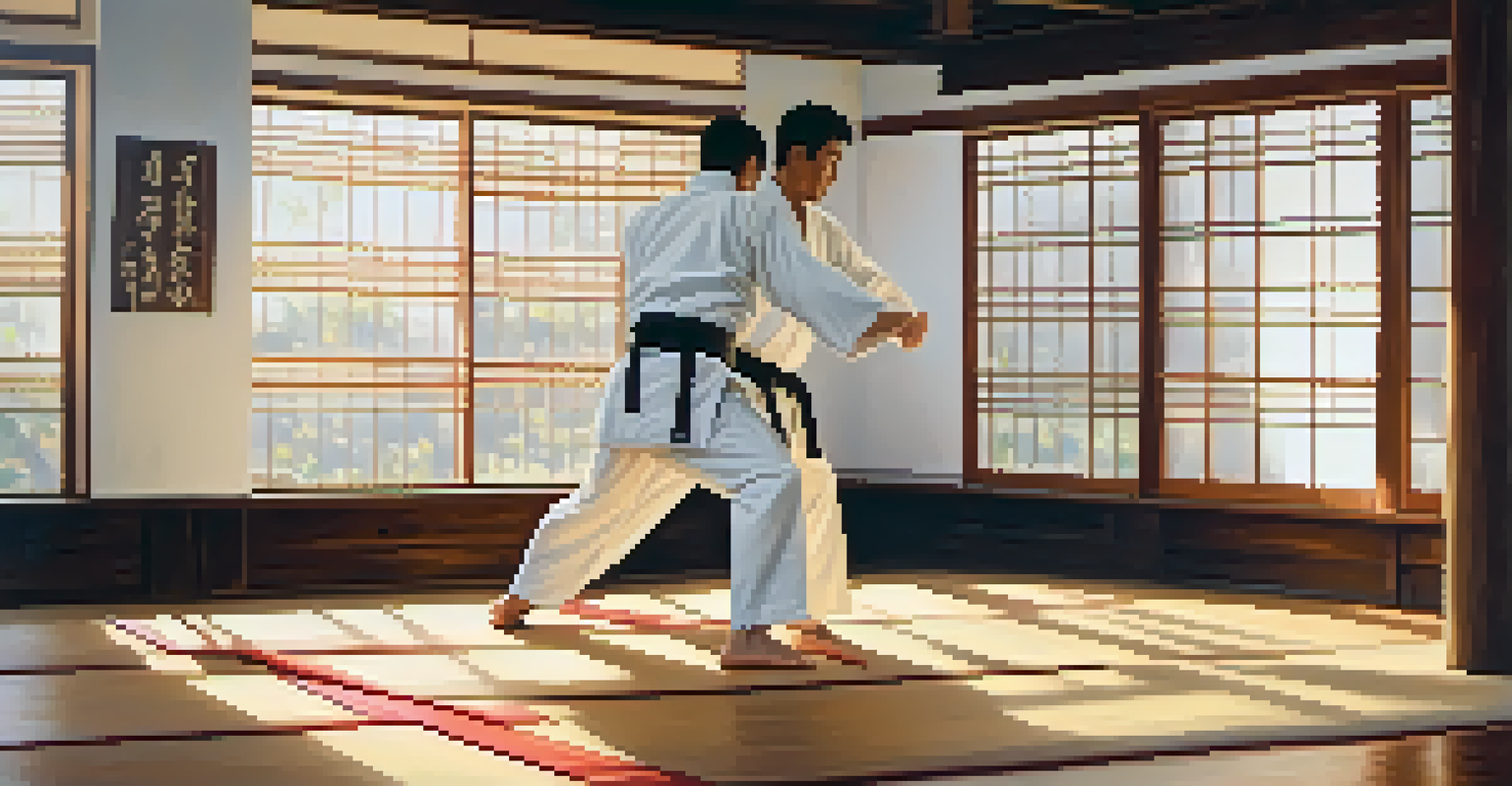Philosophical Roots of Balance in Martial Arts Techniques

Understanding Balance as a Core Principle
Balance is often viewed as a physical skill, but in martial arts, it runs much deeper. It represents harmony between mind and body, which is essential for executing techniques effectively. Just as a well-tuned instrument produces beautiful music, a balanced practitioner executes movements with grace and precision.
Balance is not something you find, it's something you create.
In many martial arts traditions, achieving balance is not solely about maintaining physical stability. It involves a mental equilibrium, where clarity and focus allow practitioners to respond fluidly to challenges. This connection between mental and physical balance is what makes martial arts a holistic practice.
For instance, consider the concept of Yin and Yang, a fundamental idea in Chinese philosophy that embodies balance. In martial arts, this principle is mirrored in the interplay of soft and hard techniques, where each complements the other, showcasing that balance is about duality and integration.
The Philosophical Origins of Balance
The roots of balance in martial arts can be traced back to various philosophical traditions, including Confucianism, Taoism, and Zen Buddhism. These philosophies emphasize the importance of balance in life, advocating for a harmonious existence that reflects in martial practice. By understanding these philosophies, martial artists can deepen their appreciation for the art they practice.

Taoism, for instance, promotes the idea of 'wu wei,' or effortless action, which encourages practitioners to move fluidly and harmoniously with their surroundings. This principle is central to achieving balance in martial arts techniques, where overexertion can lead to mistakes and imbalance.
Balance: Mind and Body Harmony
In martial arts, achieving balance encompasses both physical stability and mental clarity, allowing practitioners to execute techniques with grace.
Moreover, Zen Buddhism teaches mindfulness, fostering a state of awareness that enables martial artists to remain centered and balanced during practice. This mental clarity aids in mastering techniques and responding to opponents without losing composure.
Balance in Different Martial Arts Styles
Various martial arts styles interpret balance in unique ways, reflecting their cultural and philosophical backgrounds. For example, in Aikido, practitioners focus on blending with an opponent's energy rather than opposing it directly. This approach highlights the importance of maintaining balance through cooperation and awareness.
The ability to simplify means to eliminate the unnecessary so that the necessary may speak.
Conversely, in styles like Taekwondo or Karate, balance is often achieved through precise stances and movements. Here, the emphasis is on creating a stable foundation from which to execute powerful strikes. This illustrates that balance can manifest differently depending on the technique and context.
Ultimately, regardless of the style, the underlying principle remains the same: balance is essential for effective practice. Each martial art offers its own perspective on achieving this equilibrium, enriching the practitioner's journey.
The Role of Breath in Maintaining Balance
Breath control is a critical aspect of achieving balance in martial arts. It serves as a bridge between the mind and body, allowing practitioners to stay centered and calm during practice. By focusing on their breath, martial artists can enhance their physical performance and mental clarity.
In many martial arts, specific breathing techniques are taught to help maintain balance. For instance, the practice of inhaling deeply before executing a move can provide the necessary stability and power. Conversely, exhaling during a strike can help release tension and maintain fluidity.
Philosophical Roots of Balance
Various philosophies like Taoism and Zen Buddhism emphasize the importance of balance, influencing martial artists to integrate these principles into their practice.
This connection between breath and balance underscores the importance of holistic training. By cultivating awareness of their breath, martial artists can develop a deeper understanding of their bodies and enhance their overall performance, embodying the philosophical roots of balance.
The Interplay of Strength and Flexibility
Balance in martial arts is not just about being stable; it's a dynamic interplay of strength and flexibility. While strength provides the foundation for powerful techniques, flexibility allows for fluid movement and adaptability. Together, they create a balanced martial artist capable of responding effectively to various situations.
For example, a strong stance can give a practitioner stability, but without flexibility, they may struggle to evade or counter an opponent's move. This highlights the necessity of training both qualities to achieve true balance in practice. It’s much like a tree that needs strong roots and flexible branches to withstand the wind.
Moreover, this balance of strength and flexibility is reflected in the philosophical teachings of many martial arts. By embracing both aspects, practitioners learn to cultivate resilience and adaptability, essential traits not only in martial arts but in life itself.
Balance and the Concept of Flow
Flow is a state of being where everything feels effortless, and balance plays a vital role in achieving this state in martial arts. When practitioners are balanced, they can move seamlessly through techniques, allowing their actions to feel natural and instinctive. This state of flow enhances both performance and enjoyment in practice.
In martial arts, achieving flow requires a deep understanding of timing, rhythm, and balance. Practitioners learn to synchronize their movements with their breath and the environment, leading to a harmonious experience. This is akin to a dance, where each movement is connected and fluid.
Dynamic Interplay of Strength and Flexibility
True balance in martial arts combines strength and flexibility, enabling practitioners to adapt and respond effectively in diverse situations.
Cultivating flow also reflects the philosophical teachings of being present and mindful. When martial artists focus on their movements, they transcend the distractions of the outside world, embodying the essence of balance and flow in their practice.
The Lifelong Journey of Balancing Practice
The pursuit of balance in martial arts is not a destination but a lifelong journey. As practitioners progress, they continually refine their understanding of balance, integrating new techniques and philosophies into their practice. Each stage of this journey offers unique lessons that enhance both martial skills and personal growth.
For instance, beginners may focus on basic stances and movements, while advanced practitioners explore the subtleties of balance in complex techniques. This evolution illustrates that balance is not static; it adapts and grows with the practitioner. Like climbing a mountain, the view gets better as you ascend.

Ultimately, the journey of balancing practice reflects the broader philosophical principles of martial arts. By embracing this ongoing process, practitioners learn to cultivate patience, resilience, and a deeper connection to themselves and their art.